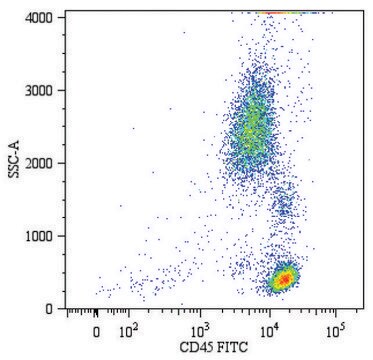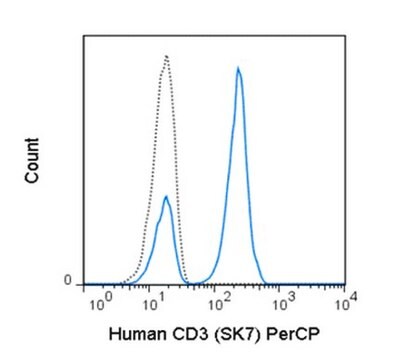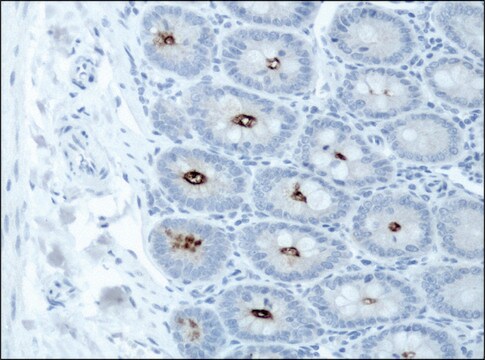SAB4700164
Monoclonal Anti-CD34-PE antibody produced in mouse
clone 4H11[APG], purified immunoglobulin, buffered aqueous solution
Sinonimo/i:
Anti-Mucosialin
Autenticatiper visualizzare i prezzi riservati alla tua organizzazione & contrattuali
About This Item
Codice UNSPSC:
12352203
NACRES:
NA.44
Prodotti consigliati
Origine biologica
mouse
Livello qualitativo
Coniugato
phycoerythrin (R-PE) conjugate
Forma dell’anticorpo
purified immunoglobulin
Tipo di anticorpo
primary antibodies
Clone
4H11[APG], monoclonal
Stato
buffered aqueous solution
Reattività contro le specie
human
tecniche
flow cytometry: suitable
Isotipo
IgG1
N° accesso NCBI
N° accesso UniProt
Condizioni di spedizione
wet ice
Temperatura di conservazione
2-8°C
modifica post-traduzionali bersaglio
unmodified
Informazioni sul gene
human ... CD34(947)
Descrizione generale
The antibody 4H11[APG] reacts with Class III epitope on CD34 (Mucosialin), a 110-115 kDa monomeric transmembrane phosphoglycoprotein expressed on hematopoietic progenitors cells and on the most pluripotential stem cells; it is gradually lost on progenitor cells. The antibody 4H11[APG] completely blocks binding of Class II antibody QBEnd10 and Class III antibodies BIRMA K3 and 8G12 on KG1a cell line.
Immunogeno
Permanent human cell line derived from peripheral leucocytes of a patient suffering from chronic myeloid leukaemia.
Applicazioni
The reagent is designed for Flow Cytometry analysis of human blood cells using 20 μL reagent / 100 μL of whole blood or 1e6 cells in a suspension. The content of a vial (2 mL) is sufficient for 100 tests.
Caratteristiche e vantaggi
Evaluate our antibodies with complete peace of mind. If the antibody does not perform in your application, we will issue a full credit or replacement antibody. Learn more.
Stato fisico
Solution in phosphate buffered saline containing 15 mM sodium azide and 0.2% high-grade protease free BSA as a stabilizing agent.
Esclusione di responsabilità
Unless otherwise stated in our catalog or other company documentation accompanying the product(s), our products are intended for research use only and are not to be used for any other purpose, which includes but is not limited to, unauthorized commercial uses, in vitro diagnostic uses, ex vivo or in vivo therapeutic uses or any type of consumption or application to humans or animals.
Non trovi il prodotto giusto?
Prova il nostro Motore di ricerca dei prodotti.
Codice della classe di stoccaggio
10 - Combustible liquids
Classe di pericolosità dell'acqua (WGK)
WGK 2
Punto d’infiammabilità (°F)
Not applicable
Punto d’infiammabilità (°C)
Not applicable
Scegli una delle versioni più recenti:
Possiedi già questo prodotto?
I documenti relativi ai prodotti acquistati recentemente sono disponibili nell’Archivio dei documenti.
Melanie Werner-Klein et al.
PloS one, 9(5), e97860-e97860 (2014-05-17)
Tumor xenografts in immunodeficient mice, while routinely used in cancer research, preclude studying interactions of immune and cancer cells or, if humanized by allogeneic immune cells, are of limited use for tumor-immunological questions. Here, we explore a novel way to
K Elknerová et al.
Neoplasma, 54(4), 311-320 (2007-09-08)
Growth-inhibitory and proapoptotic effects of the monoclonal antibody to CD34 molecule, clone 4H11, were tested in CD34+ leukemic cell lines (MOLM-9, JURL-MK1, HEL) and CD34- cell lines (PS-1, ML-2 and CTV-1). We have found that the monoclonal antibody to CD34
Libing Wang et al.
Annals of hematology, 93(10), 1685-1694 (2014-05-23)
Acute myeloid leukemia (AML) is generally regarded as a disorder of stem cells, known as leukemic initiating cells (LICs), which initiate the disease and contribute to relapses. Although the phenotype of these cells remains unclear in most patients, they are
Mirelle J A J Huijskens et al.
Journal of leukocyte biology, 96(6), 1165-1175 (2014-08-27)
The efficacy of donor HSCT is partly reduced as a result of slow post-transplantation immune recovery. In particular, T cell regeneration is generally delayed, resulting in high infection-related mortality in the first years post-transplantation. Adoptive transfer of in vitro-generated human
Global Trade Item Number
| SKU | GTIN |
|---|---|
| SAB4700164-100TST | 4061838165374 |
Il team dei nostri ricercatori vanta grande esperienza in tutte le aree della ricerca quali Life Science, scienza dei materiali, sintesi chimica, cromatografia, discipline analitiche, ecc..
Contatta l'Assistenza Tecnica.








